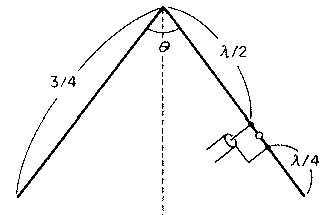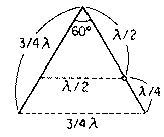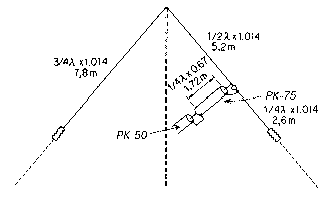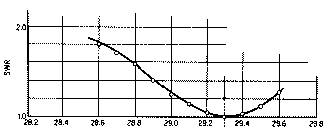Efficient DX Antenna. Encyclopedia of radio electronics and electrical engineering

Encyclopedia of radio electronics and electrical engineering / HF antennas
 Comments on the article
Comments on the article
JA7RKB offers an efficient 2x3/4 Inv.V DX antenna (Figure 1).


Ris.1
With such an arrangement of the antenna web, when the centers of the extreme half-wave sections are at a distance of half a wavelength, their radiation fields are added. The quarter-wave sections of the canvas, located at the top of the antenna, have practically no effect on the radiation pattern.

Ris.2
Figure 2 shows the dimensions of the antenna for an average operating frequency of 29,2 MHz, and Figure 3 shows the frequency dependence of its SWR.

Ris.3
According to JA7RKB and his DX correspondents, this vertically polarized antenna radiates at very small angles to the horizon and on long paths is 2-3 points more efficient than a conventional half-wave dipole.
Author: JA7RKB; Publication: N. Bolshakov, rf.atnn.ru
 See other articles Section HF antennas.
See other articles Section HF antennas.
 Read and write useful comments on this article.
Read and write useful comments on this article.
<< Back
 Latest news of science and technology, new electronics:
Latest news of science and technology, new electronics:
Machine for thinning flowers in gardens
02.05.2024
In modern agriculture, technological progress is developing aimed at increasing the efficiency of plant care processes. The innovative Florix flower thinning machine was presented in Italy, designed to optimize the harvesting stage. This tool is equipped with mobile arms, allowing it to be easily adapted to the needs of the garden. The operator can adjust the speed of the thin wires by controlling them from the tractor cab using a joystick. This approach significantly increases the efficiency of the flower thinning process, providing the possibility of individual adjustment to the specific conditions of the garden, as well as the variety and type of fruit grown in it. After testing the Florix machine for two years on various types of fruit, the results were very encouraging. Farmers such as Filiberto Montanari, who has used a Florix machine for several years, have reported a significant reduction in the time and labor required to thin flowers.
... >>
Advanced Infrared Microscope
02.05.2024
Microscopes play an important role in scientific research, allowing scientists to delve into structures and processes invisible to the eye. However, various microscopy methods have their limitations, and among them was the limitation of resolution when using the infrared range. But the latest achievements of Japanese researchers from the University of Tokyo open up new prospects for studying the microworld. Scientists from the University of Tokyo have unveiled a new microscope that will revolutionize the capabilities of infrared microscopy. This advanced instrument allows you to see the internal structures of living bacteria with amazing clarity on the nanometer scale. Typically, mid-infrared microscopes are limited by low resolution, but the latest development from Japanese researchers overcomes these limitations. According to scientists, the developed microscope allows creating images with a resolution of up to 120 nanometers, which is 30 times higher than the resolution of traditional microscopes. ... >>
Air trap for insects
01.05.2024
Agriculture is one of the key sectors of the economy, and pest control is an integral part of this process. A team of scientists from the Indian Council of Agricultural Research-Central Potato Research Institute (ICAR-CPRI), Shimla, has come up with an innovative solution to this problem - a wind-powered insect air trap. This device addresses the shortcomings of traditional pest control methods by providing real-time insect population data. The trap is powered entirely by wind energy, making it an environmentally friendly solution that requires no power. Its unique design allows monitoring of both harmful and beneficial insects, providing a complete overview of the population in any agricultural area. “By assessing target pests at the right time, we can take necessary measures to control both pests and diseases,” says Kapil ... >>
 Random news from the Archive Random news from the Archive Super solar flare could destroy all electronics on Earth
08.01.2013
Adrian Melott (Adrian Melott) from the University of Kansas at Lawrence (USA) and his colleague Brian Thomas (Brian Thomas) from Washburn University in Topeka (USA) studied the "superflare" on the Sun in the 774th century AD, whose traces were recently found in annual rings of Japanese cedars. A solar superflare in 1859 turned out to be several times more powerful than the previous record holder, the "Carrington event" of XNUMX, capable of destroying all electronic devices and electrical networks on Earth, astronomers say in an article posted in the electronic library of Cornell University.
Flashes periodically occur on the Sun - explosive episodes of energy release in the form of visible light, heat and X-rays. It is believed that the most powerful outbreak occurred in 1859 during the so-called "Carrington event". During this powerful outbreak, approximately 10 yottojoules (1025) of energy were released, which is 20 times the energy released during the meteorite impact that destroyed dinosaurs and marine reptiles.
The discoverers of the ancient outbreak, Japanese physicists led by Fusa Miyake from the University of Nagoya (Japan), considered it a so-called "superflare", the power of which exceeded all known bursts of solar activity by several orders of magnitude. Melott and Thomas tried to calculate the exact amount of energy that could have been released during the superflare in 774. To do this, scientists calculated the proportion of radioactive carbon-14 in the annual rings of cedars and determined the amount of energy that was brought to Earth by a flash. Astronomers then tried to calculate the energy of the ejection on the Sun itself by changing the area of the flare and the proportion of its matter that reached our planet.
It turned out that the flash power was two orders of magnitude lower than the maximum values predicted by their colleagues. However, this does not deprive the 774 event of the status of a "superflare". According to researchers' calculations, about 774 yottojoules (200 * 2) of energy were released on the Sun during the burst of 1026, which is 20 times more than the power of the "Carrington event".
A similar cataclysm today would lead not only to the destruction of electronics on board satellites and the Earth's surface, but also to the appearance of other anomalies. Thus, the share of ozone at the boundaries of the stratosphere and troposphere would decrease by 20% in the first months after the outbreak and would remain low for several years.
According to Melott and Thomas, this would lead to a deterioration in the health of plants and animals around the world, and an increase in the incidence of skin cancer. However, a mass extinction of flora and fauna is unlikely, which adds another argument in favor of the realism of such outbreaks. According to the authors of the article, such "superflares" can occur once every 1250 years, which underlines the importance of observing the "health" of the Sun, given their catastrophic consequences for the infrastructure of modern civilization.
|
 Other interesting news:
Other interesting news:
▪ Patton CopperLink 1101 Kit
▪ Samsung U32D970Q UHD Monitor
▪ DNA instead of a hard drive
▪ Key innovations for the next 10 years
▪ Canopus pocket TV tuner
 News feed of science and technology, new electronics
News feed of science and technology, new electronics
 Interesting materials of the Free Technical Library:
Interesting materials of the Free Technical Library:
▪ section of the Garland website. Article selection
▪ article by Decimus Junius Juvenal. Famous aphorisms
▪ article How many types of insects exist in nature? Detailed answer
▪ article editor-in-chief. Job description
▪ article Checking the health of the rear light. Encyclopedia of radio electronics and electrical engineering
▪ article Device for protecting a three-phase asynchronous motor in the event of a fuse failure. Encyclopedia of radio electronics and electrical engineering
 Leave your comment on this article:
Leave your comment on this article:
 All languages of this page
All languages of this page
Home page | Library | Articles | Website map | Site Reviews

www.diagram.com.ua
2000-2024







 Arabic
Arabic Bengali
Bengali Chinese
Chinese English
English French
French German
German Hebrew
Hebrew Hindi
Hindi Italian
Italian Japanese
Japanese Korean
Korean Malay
Malay Polish
Polish Portuguese
Portuguese Spanish
Spanish Turkish
Turkish Ukrainian
Ukrainian Vietnamese
Vietnamese




 Leave your comment on this article:
Leave your comment on this article: